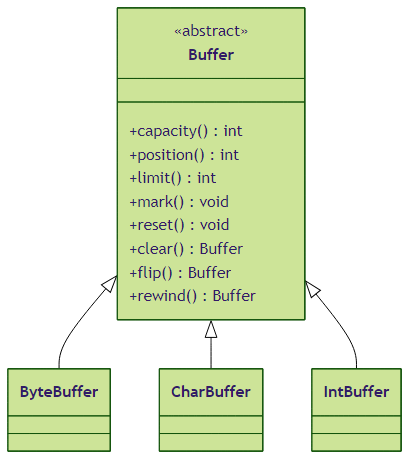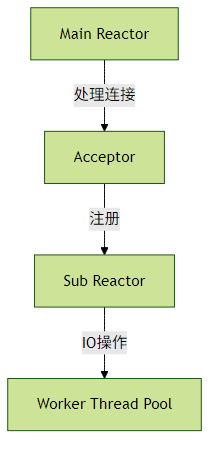Java NIO与异步IO深度解析及性能优化指南
Java异步IO与NIO深度解析
一、NIO核心组件解析
1. Channel通道机制
Channel是NIO的核心抽象之一,代表与I/O设备的连接,支持非阻塞读写操作。主要实现类包括:
- FileChannel:文件IO通道
- SocketChannel:TCP网络套接字通道
- ServerSocketChannel:服务端监听通道
- DatagramChannel:UDP通道
// 文件通道示例
try (FileChannel channel = FileChannel.open(Paths.get("data.txt"),
StandardOpenOption.READ)) {
ByteBuffer buffer = ByteBuffer.allocate(1024);
while (channel.read(buffer) > 0) {
buffer.flip();
// 处理buffer数据
buffer.clear();
}
}实践建议:
- 对于大文件处理优先使用
FileChannel.transferTo/transferFrom实现零拷贝 - 网络通信时设置
configureBlocking(false)启用非阻塞模式
2. Buffer内存管理
Buffer是NIO的数据容器,核心属性:
- capacity:缓冲区容量
- position:当前读写位置
- limit:可读写边界
- mark:临时标记位置

堆外内存实践:
// 分配堆外内存
ByteBuffer directBuffer = ByteBuffer.allocateDirect(1024);
// 内存映射文件
FileChannel channel = FileChannel.open(path);
MappedByteBuffer mappedBuffer = channel.map(
FileChannel.MapMode.READ_WRITE, 0, channel.size());性能对比:
| 类型 | 内存位置 | GC管理 | 读写速度 |
|---|---|---|---|
| HeapBuffer | JVM堆 | 是 | 较慢 |
| DirectBuffer | 堆外 | 否 | 较快 |
3. Selector多路复用
Selector是NIO实现高并发的关键,允许单线程监控多个Channel的IO事件。
Selector selector = Selector.open();
SocketChannel channel = SocketChannel.open();
channel.configureBlocking(false);
channel.register(selector, SelectionKey.OP_READ);
while (true) {
int readyChannels = selector.select();
if (readyChannels == 0) continue;
Set<SelectionKey> selectedKeys = selector.selectedKeys();
Iterator<SelectionKey> keyIterator = selectedKeys.iterator();
while (keyIterator.hasNext()) {
SelectionKey key = keyIterator.next();
if (key.isReadable()) {
// 处理读事件
}
keyIterator.remove();
}
}事件类型:
- OP_ACCEPT:连接接受
- OP_CONNECT:连接完成
- OP_READ:读就绪
- OP_WRITE:写就绪
二、Netty框架高级实践
1. Reactor模式实现
Netty基于主从Reactor多线程模型:

核心组件:
- EventLoopGroup:事件循环组
- ChannelPipeline:处理器链
- ChannelHandler:业务处理器
EventLoopGroup bossGroup = new NioEventLoopGroup(1);
EventLoopGroup workerGroup = new NioEventLoopGroup();
try {
ServerBootstrap b = new ServerBootstrap();
b.group(bossGroup, workerGroup)
.channel(NioServerSocketChannel.class)
.childHandler(new ChannelInitializer<SocketChannel>() {
@Override
public void initChannel(SocketChannel ch) {
ch.pipeline().addLast(new EchoServerHandler());
}
});
ChannelFuture f = b.bind(8080).sync();
f.channel().closeFuture().sync();
} finally {
workerGroup.shutdownGracefully();
bossGroup.shutdownGracefully();
}2. 零拷贝优化
Netty通过以下方式实现零拷贝:
- 文件传输:使用
FileRegion直接传输文件内容 - 复合缓冲区:
CompositeByteBuffer合并多个Buffer - 内存池:
PooledByteBufAllocator重用缓冲区
// 文件零拷贝示例
File file = new File("largefile.iso");
FileRegion region = new DefaultFileRegion(
file, 0, file.length());
channel.writeAndFlush(region);3. 内存池技术
Netty内存池管理机制:

配置建议:
// 启用内存池
bootstrap.option(ChannelOption.ALLOCATOR, PooledByteBufAllocator.DEFAULT)
.childOption(ChannelOption.ALLOCATOR, PooledByteBufAllocator.DEFAULT);三、性能调优实践
1. NIO参数调优
// Linux内核参数优化
java -Djava.nio.channels.spi.SelectorProvider=sun.nio.ch.EPollSelectorProvider
-Dio.netty.selectorAutoRebuildThreshold=5122. Netty最佳配置
| 参数 | 推荐值 | 说明 |
|---|---|---|
| SO_BACKLOG | 1024 | 等待连接队列长度 |
| SO_REUSEADDR | true | 端口重用 |
| TCP_NODELAY | true | 禁用Nagle算法 |
| SO_KEEPALIVE | true | 保持连接检测 |
| WRITE_BUFFER_WATER_MARK | 32KB/64KB | 写水位控制 |
四、常见问题排查
Selector空轮询问题
- 现象:CPU 100%
- 解决方案:升级Netty版本或使用EPollSelector
内存泄漏检测
// 启用内存泄漏检测 ResourceLeakDetector.setLevel(ResourceLeakDetector.Level.PARANOID);堆外内存监控
# 查看DirectMemory使用 jcmd <pid> VM.native_memory
总结
Java NIO和Netty的高性能源于三大设计:
- 事件驱动模型减少线程开销
- 零拷贝技术降低内存复制
- 内存池化设计避免频繁分配
对于现代分布式系统,建议:
- 网关类应用优先采用Netty实现
- 文件服务使用FileChannel零拷贝
- 长连接服务配合EPoll优化